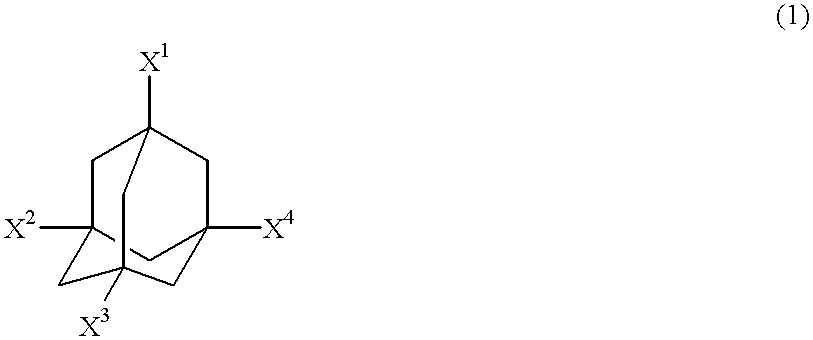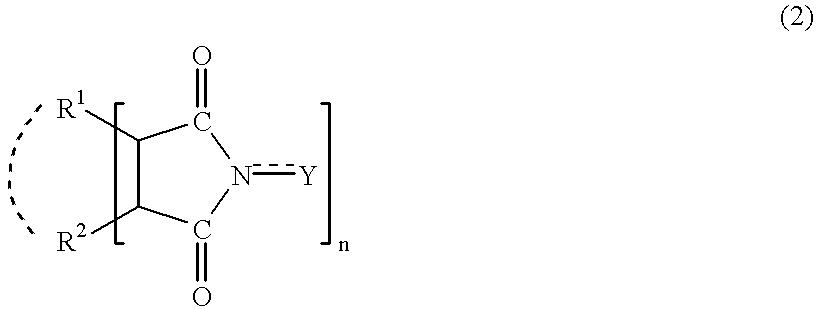Adamantane derivatives and process for producing them
a technology of adamantane and derivatives, which is applied in the direction of organic compounds/hydrides/coordination complexes, physical/chemical process catalysts, organic compounds, etc., can solve the problems of difficult introduction of hydroxyl groups (specifically, a plurality of hydroxyl groups) to adamantane by using these processes
- Summary
- Abstract
- Description
- Claims
- Application Information
AI Technical Summary
Benefits of technology
Problems solved by technology
Method used
Image
Examples
example 1
Mixture of 10 mmole 1-acetylaminoadamantane (Aldrich chemical Company, Inc.), 1 mmole of N-hydroxyphthalimide (NHPI), 0.05 mmole of vanadium(III)acetylacetonato (V(AA).sub.3) and 25 mL of acetic acid was stirred under an oxygen atmosphere and the conditions represented in Table 1 (temperature and time). The products in the reaction mixture were analyzed by gas chromatography, and, as a result, 1-acetylamino-3-adamantanol (compound 1), 1-acetylamino-3,5-adamatanediol (compound 2) and 1-acetylamino-4-adamantanone (compound 3) were obtained with conversions and yields represented in Table 1.
example 2
A reactor was charged with 10 mmole of adamantane, 1 mmole of NHPI, 0.005 mmole of Co(AA).sub.2 and 25 mL of acetic acid, then equipped with a gas bag of mixed gas (a mixed gas of 2 L of carbon monoxide and 0.5 L of oxygen). The resultant mixture was stirred for 6 hours at a temperature of 60.degree. C. to give 1-carboxyadamantane and 1,3-dicarboxyadamantane.
A mixture of 10 mmole of 1-carboxyadamantane, 1 mmole of NHPI, 0.05 mmole of V(AA).sub.3 and 25 mL of acetic acid was stirred under an oxygen atmosphere and the conditions represented in Table 2 (time and temperature). As a result, 1-carboxy-3-adamantanol (compound 1), 1-carboxy-3,5-adamatanediol (compound 2) and 1-carboxy-4-adamantanone (compound 3) were obtained with conversions and yields represented in Table 2.
example 3
In the presence of an acid catalyst (p-toluenesulfonic acid), 1-carboxyadamantane obtained in Example 2 was allowed to react with an excess amount of ethanol to give 1-ethoxycarbonyladamantane.
A mixture of 10 mmole of the 1-ethoxycarboxyadamantane, 1 mmole of NHPI, 0.05 mmole of V(AA).sub.3 and 25 mL of acetic acid was stirred under an oxygen atmosphere and the conditions represented in Table 3 (temperature and time). As a result, 1-ethoxycarbonyl-3-adamantanol (compound 1), 1-ethoxycarbonyl-3,5-adamatanediol (compound 2) and 1-ethoxy-4-carbonyladamantanone (compound 3) were obtained with conversions and yields represented in Table 3.
PUM
| Property | Measurement | Unit |
|---|---|---|
| pressure | aaaaa | aaaaa |
| pressure | aaaaa | aaaaa |
| temperature | aaaaa | aaaaa |
Abstract
Description
Claims
Application Information
 Login to View More
Login to View More - R&D
- Intellectual Property
- Life Sciences
- Materials
- Tech Scout
- Unparalleled Data Quality
- Higher Quality Content
- 60% Fewer Hallucinations
Browse by: Latest US Patents, China's latest patents, Technical Efficacy Thesaurus, Application Domain, Technology Topic, Popular Technical Reports.
© 2025 PatSnap. All rights reserved.Legal|Privacy policy|Modern Slavery Act Transparency Statement|Sitemap|About US| Contact US: help@patsnap.com



